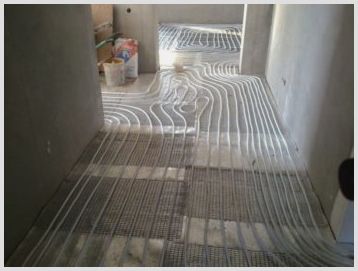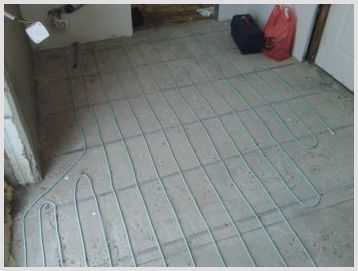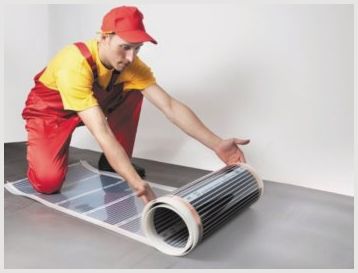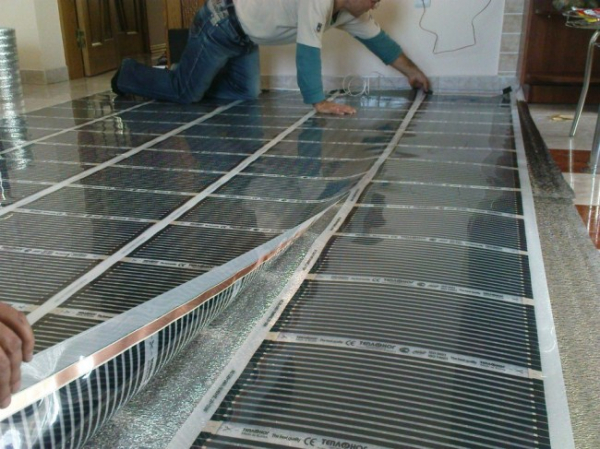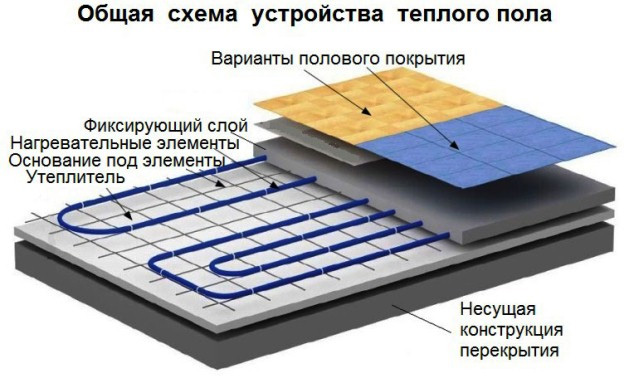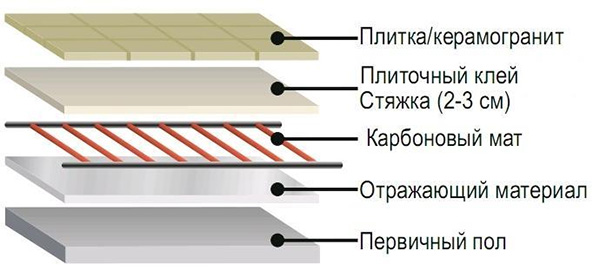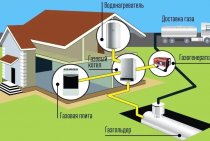Electric floor heating
Compared to water heating, electrical systems are characterized by:
- Fewer components are required - often only an additional thermostat is needed. In addition, calculations and installation are simpler and faster.
- There are no emergencies related to coolant leaks. The screed is made thinner, the largest thickness is 30 mm. In some cases, they are limited to a leveling layer device, which greatly simplifies repair and maintenance.
- Setup and adjustment is easier and there are more customization options.
Film or infrared underfloor heating
The name is not entirely correct, all electric underfloor heating systems emit heat energy more in the infrared range.

Heating films are also used simply as heating elements, they can be laid under carpets or carpet, under any rolled materials - laminate, linoleum. For installation under ceramic tiles, you need to perform high-quality surface preparation.

The base must be level and rigid. A waterproofing material is laid on the film, as a rule, plasterboard sheets and polymeric materials. Waterproofing must be done very high quality. High room humidity is a limitation on the installation of a film floor under a tile, for the reason that the films do not have a ground.

Underfloor heating with heating cables
They are considered one of the simplest and most reliable solutions. The cable is mounted on the prepared floor base, laying it with a “snake” and fixing it with a mounting tape or special clamps. The convenience of laying a flexible cable makes it possible to bypass any obstacles, in any configuration of the room.

After the cable is installed, the sensors are installed, the installation locations are determined by calculation. The length of the heating cable must be calculated in advance.

All heat must go up to floor heating. For this, thermal insulation materials of a reflective type are used, foil insulation on a soft base made of cork or polypropylene.

A tie device with a thickness of 30 mm or more in the case of using heating wires is necessary to protect the wires from mechanical damage. The wires are laid in a cement-sand screed, and after the mortar has gained strength, ceramic tiles are laid on the adhesive.

Alternatively, the wires are sometimes mounted directly into the adhesive layer when the tiles are laid. This reduces the installation time for underfloor heating, but can create a problem in the future - if you have to replace a tile or two, then dismantling the tiles can easily damage the heating wires.

Heated floors from heating mats
A more convenient heating system with heating cables, which are factory-mounted on the mounting grid. The mesh is supplied in rolls of certain sizes. Thus, the capacities have already been determined and no additional calculations are required, you only need to mount the thermomats, connect and plug them into the socket.

In this case, it is not necessary to arrange a cement-sand screed. The grid on which the wires are fixed is protective. Tile adhesive is applied directly to the thermomats and ceramic tiles are laid on them.

If it is planned to replace the tiles, then it is possible to fill the thermomats with a leveling mass (self-leveling screed) 3-4 mm thick.

Water heated floor
The main elements of this heating system are pipes recessed into the screed layer and a thermal insulating substrate. To mount such a system in an apartment located in a multi-storey building, you need to obtain permission.

There are several reasons:
- It is necessary to calculate whether the additional load from the structure of the water floor and the concrete screed will exceed the permissible load on the floor, since the screed is made of considerable thickness.
- When connecting a water floor in an apartment, the installation of an individual boiler is required; it is forbidden to connect to the central heating system.

When deciding to arrange a water heated floor, you should understand:
- It will not be possible to design and mount this system without professional knowledge and experience. Calculations should be done by specialists, an amateur installation usually gives an inefficient system that has too much heat loss.
- Pipes and fittings poured into the screed will be inaccessible, and in the event of a malfunction, it will be necessary to open the concrete coating, while components are easily damaged.
- The water floor system additionally loads the autonomous heating system of a private house, and if the boiler was installed not “for the future”, but with minimal parameters, then it will have to be replaced with a more powerful one. The best option is to design a water floor along with the house, and do the installation along with the floor device. This eliminates future repairs, dismantling and dirty work.
- It is rational to heat large rooms with a pipe system, with small ones it is unprofitable.
- It is not possible to regulate the room temperature by turning off the hot water supply partially. It will be possible to disable only a room or a group of rooms, depending on the parameters of the applied collector. The presence of thermal inertia in this case is the cause of unnecessary heat costs.
As a result: it is possible to arrange water-heated floors under ceramics, but this option is most rational for private houses with large areas of premises and the presence of an autonomous heating boiler of sufficient power.
Advantages of underfloor heating in the hallway
- Thrift. The design heats the area as much as possible, as it is equipped with thermostats that maintain the temperature appropriate for the owner of the house without spending additional energy.
- Environmental friendliness. Dust does not rise into the air and does not enter the respiratory tract of a person, as happens when the room is heated by radiators.
- Versatility. The heating structure does not interfere with the arrangement of furniture, does not take up space. To do this, you must choose any appropriate system: water, electric or film.
- Practicality. Warming up protects against drafts coming from the front door. The air in the room is heated to a height of one and a half meters throughout the territory. Right there, at the entrance, you can ennoble a warm place for a pet.
Selection of floor heating system
Having decided to ennoble the heated floor, the main thing is to choose the appropriate design for heating. The selection depends on the floor covering option, financial capabilities, personal desires and the one who carries out the installation process (a team of employees, with their own hands).
Water heating
Laying out the pipes of the hydraulic heating system
The floor heating system is used all the time: in office premises, apartments, houses. In its own design, it has elastic plastic pipe contours in which hot water moves. Heating is changed using the usual room thermostat. If the installation process is done qualitatively, the probability of leakage is up to zero. The heating system has a low price, it has no electromagnetic radiation.
Attention! This design takes into account the raising of the floor level to the height of the screed - up to 10 cm
Heated Cable Floor Electric Sample
Laid wire in the hallway
The heating system consists of an electric cable (single, two-wire) laid under a concrete screed and a temperature controller. The heating best suited for installation under ceramic tiles, other coatings. Equip it in the hallway, kitchen, bathroom and even in residential premises.The advantage of such a system is not considered a difficult installation process, but the cable floor is costly to operate due to excessive consumption of electrical energy.
Electric mats for underfloor heating
If we compare it with laying the floor from the cable, then the process of installing mats will be performed by any home craftsman. Mats lay down without a screed - glue is applied. In such a heating system, an electric cable with the required pitch is placed on the grid. Thanks to this, it remains to cut the grid, place the mats. The main thing is to make sure that the loops of the electric cable do not intersect with each other, do not touch each other. The disadvantage of the system is that weighty objects (chest of drawers, wardrobe) are not placed on the mats, so you will have to design the location of the furniture in the hallway in advance
Infrared heated floor
Heating film installation process
A warm film floor is in demand because of the ease of installation. Anyone can install it with their own hands, especially that the manufacturer sells these products in kits. The installation kit includes electrical wiring, thermal film, insulation, external water thermostat, temperature sensor. The system operates on the basis of infrared radiation. Such heating is installed under ceramic tiles, carpet and other coatings. It is suitable for installation in a corridor: the cost of electrical energy is small, a concrete screed is not required. And most importantly, if some part breaks down, the heated floor continues to work in normal mode.
It is, of course, up to the owner of the house to choose which heated floor should be placed in the space of the corridor, but financial investments will primarily pay off with convenience and comfort. This allows you to raise the temperature in the space of the corridor and the apartment in the cold season.
Underfloor heating in the hallway:
Reasons for arranging heating in the hallway
The entrance hall is considered the place that determines the first opinion of guests about the house. Therefore, it is worth thinking about the materials for finishing the room, because the right design creates a feeling of harmony. Well, the heated floor in the room will add comfort.
If it is snowing or raining outside, then a warm floor helps to eliminate moisture - it is used to dry shoes. Moisture for shoes is unacceptable, and, placed on a warm surface, it will be possible to evenly dry it.
Coming home from the street, it is pleasant, having taken off your shoes, to step with your feet on the heated floor. It is laid under such popular floor materials for the corridor as laminate, tile, porcelain stoneware.
Film floor heating
Recently, film underfloor heating has become very popular due to the ease of installation; anyone can install it on their own if desired. The system works on the basis of infrared radiation. The kit includes thermal film with electrical connection, temperature controller, wiring, insulation and temperature sensor.
Underfloor heating film installation
Such a warm floor can be placed under tiles, laminate, carpet and other coverings, so it is ideal for heating the hallway. Floor screed is not needed, and energy costs are minimal. Unlike electric underfloor heating, here the film floor strips run parallel to each other. This means that if one lane breaks, all the others will continue to work as usual.
Sex Varieties
1. Water system.
This option is considered more economical, water is cheaper than electricity. Heat in the house is provided by the circulation of the carrier through metal-plastic pipes. Heating is carried out through a centralized or autonomous network. Since the system requires the use of high power pumping units, the operation of water floors in multi-storey buildings is considered impractical. In addition, installation under tiles is difficult, it is required to take into account the load factor on the floors.The apartments usually have low ceilings, arranging a screed for underfloor heating will reduce the height of the room.
2. Electrical.
The main advantage is year-round operation. The connection does not depend on the heating season, a comfortable stay in the house can be ensured in wet weather in autumn and spring. Since tiles are characterized by a high ability to conduct energy, the installation of an electric underfloor heating is an advantage.
The design is a two-core type wire with an insulating sheath. For installation, it is worth choosing a cable with a diameter not exceeding 10 mm. The distance between the elements is from 80 to 200 mm depending on the area. The laying work includes the arrangement of the screed. In total, the layer can be about 10 cm high, which is not very suitable for small rooms.
Thermomats.
This is a type of electric underfloor heating. The system consists of a two-core cable, the difference is that the wires are embedded in a fiberglass mesh in the form of loops. For installation, no screed is required, mats can be placed directly under the tiles. The thickness of the roll does not exceed 2-3 mm, the height of the room does not decrease. Installation is quite simple, the work consists in placing the carpet on a concrete base with fixation on the adhesive mixture. Then the ends of the wires are brought out to the network block, where the thermostat is installed.
infrared.
The use of this option also does without pouring the concrete mixture. The two conductors are connected along their entire length by heating radiating elements. The design is a polymer film divided into squares. Infrared underfloor heating for tiles is considered the most efficient and energy-saving. The peculiarity lies in the fact that during operation electromagnetic radiation will not be emitted. Due to convection and filling the space with negatively charged ions, the room is evenly heated. The system has a minimum thickness of about 0.3 mm and is beneficial in terms of economy. Versatility allows you to lay the film in any room, even outdoors.
